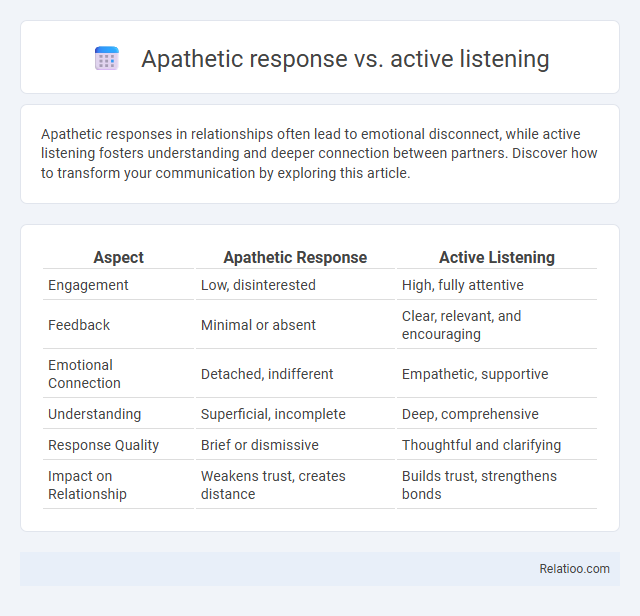Apathetic responses in relationships often lead to emotional disconnect, while active listening fosters understanding and deeper connection between partners. Discover how to transform your communication by exploring this article.
Table of Comparison
| Aspect | Apathetic Response | Active Listening |
|---|---|---|
| Engagement | Low, disinterested | High, fully attentive |
| Feedback | Minimal or absent | Clear, relevant, and encouraging |
| Emotional Connection | Detached, indifferent | Empathetic, supportive |
| Understanding | Superficial, incomplete | Deep, comprehensive |
| Response Quality | Brief or dismissive | Thoughtful and clarifying |
| Impact on Relationship | Weakens trust, creates distance | Builds trust, strengthens bonds |
Understanding Apathetic Responses
Understanding apathetic responses involves recognizing a lack of emotional engagement or interest during communication, often characterized by minimal verbal and nonverbal feedback. Unlike active listening, which includes empathetic responses, focused attention, and validating the speaker's feelings, apathetic responses can hinder effective dialogue and reduce trust. These responses may stem from disinterest, emotional exhaustion, or avoidance, underscoring the importance of addressing underlying causes to improve interpersonal connection.
Defining Active Listening
Active listening involves fully concentrating, understanding, and responding thoughtfully to the speaker, enhancing communication effectiveness. Unlike apathetic responses that show disinterest or lack of engagement, active listening requires empathy and intentional feedback to confirm comprehension. Your ability to practice active listening strengthens relationships and ensures meaningful dialogue by validating the speaker's message.
Key Differences Between Apathetic Response and Active Listening
Apathetic response is characterized by indifference and lack of engagement, whereas active listening involves fully concentrating, understanding, and responding thoughtfully to the speaker. Key differences include emotional involvement, with active listening displaying empathy and supportive feedback, while apathetic responses show minimal interest and disconnection. Active listening promotes effective communication and relationship building, contrasting with apathetic responses that often lead to misunderstandings and weakened rapport.
Signs of an Apathetic Response in Communication
Signs of an apathetic response in communication include lack of eye contact, minimal verbal feedback such as monosyllabic answers, and absence of emotional engagement or empathy. Unlike active listening, which involves nodding, asking clarifying questions, and providing thoughtful responses, apathetic communication displays disinterest and disengagement. Recognizing these signs helps improve interpersonal interactions and builds more effective, empathetic communication skills.
Characteristics of Effective Active Listening
Effective active listening is characterized by focused attention, empathetic understanding, and responsive feedback, fostering genuine communication and trust. Unlike apathetic responses, which show indifference or lack of engagement, active listening involves interpreting verbal and nonverbal cues to fully comprehend the speaker's message. This approach enhances interpersonal connections by validating feelings and encouraging open dialogue, essential in both personal and professional relationships.
Impact of Apathetic Response on Relationships
Apathetic response in relationships often leads to emotional disconnection and reduced trust, causing partners to feel ignored or undervalued. In contrast, active listening fosters empathy and understanding, strengthening communication and emotional bonds. The persistent presence of apathetic responses can erode relational intimacy, resulting in increased conflicts and potential long-term dissatisfaction.
Benefits of Practicing Active Listening
Practicing active listening fosters deeper understanding and stronger connections by fully engaging with the speaker's message, enhancing communication effectiveness. Unlike apathetic responses that signal disinterest and may damage relationships, active listening promotes empathy and trust, crucial for resolving conflicts and improving collaboration. Your ability to practice active listening can significantly boost personal and professional interactions by making others feel valued and heard.
Overcoming Barriers to Active Listening
Overcoming barriers to active listening requires recognizing and addressing apathetic responses that hinder genuine engagement and information retention. Your ability to shift from passive or apathetic attitudes to active listening techniques, such as maintaining eye contact, acknowledging emotions, and providing feedback, enhances communication effectiveness. Implementing strategies to overcome distractions, bias, and preconceptions ensures a deeper connection and understanding in every conversation.
Strategies to Shift from Apathetic to Engaged Communication
Shifting from apathetic response to engaged communication requires intentional strategies like practicing active listening, which involves fully concentrating, understanding, and responding thoughtfully to the speaker. You can enhance engagement by asking open-ended questions, providing feedback, and showing empathy to validate the speaker's feelings and perspectives. Prioritizing mindfulness and emotional awareness helps overcome disengagement, making your conversations more meaningful and effective.
Cultivating a Culture of Active Listening
Cultivating a culture of active listening involves shifting from apathetic responses, which show disinterest or disengagement, to fully engaged communication that enhances understanding and trust. Active listening requires attention to verbal and nonverbal cues, empathetic feedback, and thoughtful responses that validate the speaker's message. Organizations emphasizing active listening improve collaboration, reduce misunderstandings, and foster a respectful environment where all voices are valued.

Infographic: Apathetic response vs Active listening
 relatioo.com
relatioo.com